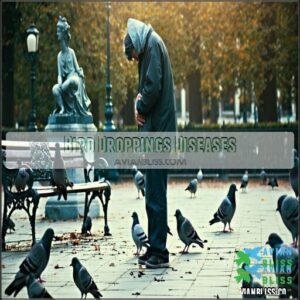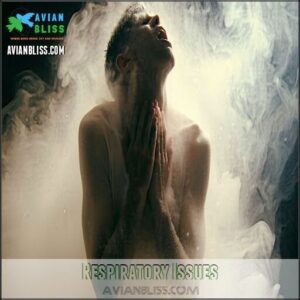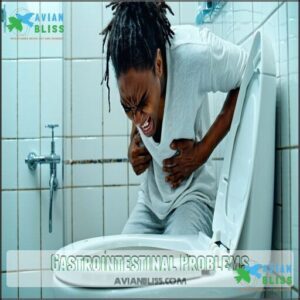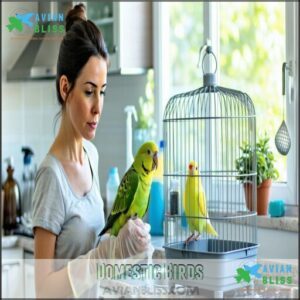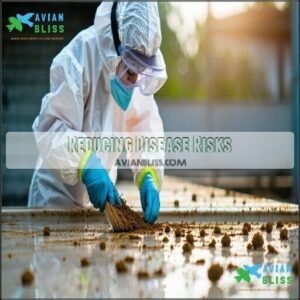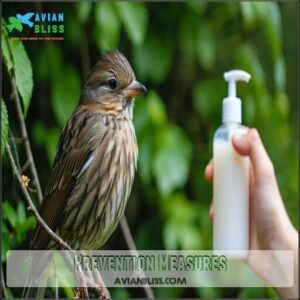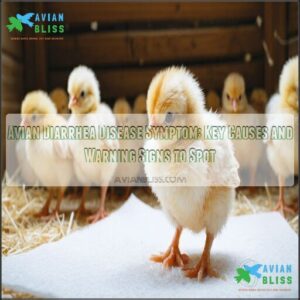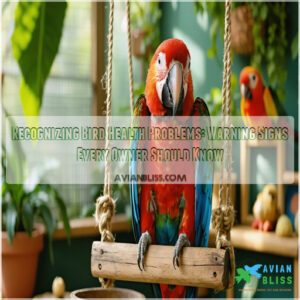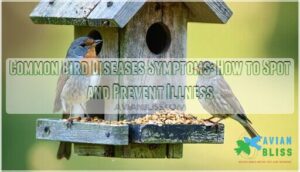This site is supported by our readers. We may earn a commission, at no cost to you, if you purchase through links.

These changes can indicate serious conditions like avian influenza, psittacosis, or salmonellosis.
If you’re caring for birds, watch for droppings that are watery, discolored (especially green, yellow, or red), or contain undigested food.
Don’t panic at the occasional odd dropping; everyone has bad digestive days, even our feathered friends! However, consistent changes warrant immediate veterinary attention.
Quick action can prevent disease spread to other birds or humans, which is a serious condition that might surprise you with the specific pathogens lurking in those messy droppings.
Table Of Contents
- Key Takeaways
- Bird Droppings Diseases
- Transmission Routes
- High Risk Groups
- Disease Symptoms
- Bird Species Risks
- Environmental Risks
- Reducing Disease Risks
- Disease Diagnosis
- Health Effects
- Prevention Measures
- Frequently Asked Questions (FAQs)
- What diseases are associated with bird droppings?
- What happens when one catches the bird flu?
- Are bird droppings a fungal disease?
- What causes bird droppings?
- Are bird droppings a breeding ground for diseases?
- How do bird droppings spread disease?
- Can bird dropping diseases affect pets?
- How long do pathogens survive in droppings?
- Are bird feeders potential disease sources?
- Can these diseases spread between humans?
- Conclusion
Key Takeaways
- You’ll notice unusual bird droppings when they change color, consistency, or frequency—these often signal serious conditions like avian influenza, psittacosis, or salmonellosis.
- You’re at risk of contracting over 60 different diseases from bird droppings through inhalation, ingestion, or contact with contaminated surfaces.
- You can protect yourself by wearing proper protective equipment (gloves, N95 masks) when cleaning droppings, washing hands thoroughly afterward, and following safe cleaning procedures.
- You’ll need immediate medical attention if you experience symptoms like respiratory issues, gastrointestinal problems, or neurological signs after exposure to bird droppings.
Bird Droppings Diseases
You’re at risk of contracting over 60 different diseases from bird droppings, including serious infections like histoplasmosis, cryptococcosis, and avian influenza.
Bird droppings harbor over 60 diseases that can enter your body through inhalation, ingestion, or contact with contaminated surfaces.
These pathogens can enter your body through inhalation, ingestion, or direct contact with contaminated surfaces, potentially causing respiratory issues, gastrointestinal problems, and even neurological symptoms if left untreated.
Avian Influenza
Avian influenza, commonly known as bird flu, can sneak up on you through contact with infected bird droppings.
This H5N1 strain poses serious pandemic potential, causing respiratory issues, fever, and muscle aches in humans.
While rare, transmission occurs when you handle contaminated materials or breathe airborne particles from dried feces.
Antiviral treatments exist, but vaccine development continues as the virus evolves.
Those working directly with birds face the highest risk.
Psittacosis
While bird flu grabs headlines, don’t overlook Psittacosis (parrot fever) – a bacterial infection caused by Chlamydia psittaci.
You can catch this respiratory infection through contact with contaminated bird droppings that remain hazardous for weeks.
Symptoms include fever, cough, and headaches appearing 5-19 days after exposure.
Bird owners should note that many infected birds show no symptoms, and early antibiotic treatment is effective, so seek medical attention promptly if symptoms develop.
Salmonellosis
While Psittacosis affects respiratory systems, Salmonellosis targets your gut with bacterial precision.
This common infection, caused by various Salmonella strains through bird droppings, creates uncomfortable gastrointestinal symptoms when bacteria make their unwelcome entrance. Symptoms include diarrhea, fever, and abdominal cramps.
Your risk increases when you:
- Handle contaminated bird materials without gloves
- Forget handwashing after bird contact
- Clean cages without proper protection
- Encounter food contamination from poultry link or zoonotic transmission
Salmonellosis doesn’t discriminate—unlike antibiotic resistance, which makes some cases tougher to treat, and it is essential to be aware of the gastrointestinal symptoms and take precautions to avoid bacterial precision in your daily interactions with birds or their environments.
Cryptococcosis
While Salmonella affects your digestive system, Cryptococcosis targets your lungs and brain.
This sneaky fungal infection, caused by Cryptococcus neoformans, loves hiding in pigeon droppings.
When you disturb dried bird poop, you might breathe in fungal spores that can trigger serious health problems, especially if your immune response is compromised.
Environmental spread occurs easily in areas with high concentrations of bird droppings, making proper cleanup essential for preventing this fungal bird dropping disease.
Histoplasmosis
While cryptococcosis primarily affects the lungs, Histoplasmosis takes a similar route through your respiratory system.
Caused by Histoplasma capsulatum fungus thriving in soil enriched with bird droppings, this infection spreads when you breathe in disturbed spores.
You’ll notice flu-like symptoms in mild cases, but don’t be fooled—severe infections can spread beyond your lungs.
The good news? Most cases resolve without treatment, though immunocompromised individuals face greater risks.
Diagnosis often involves detecting the fungus in samples.
Transmission Routes
How do bird diseases actually reach your body? Through direct contact with droppings when you touch contaminated surfaces and then your face.
You’re also at risk from airborne particles created when dried droppings are disturbed. Food contamination occurs when bird feces contaminate your meals or water.
Open wounds and mucous membranes (eyes, nose, mouth) provide easy entry points for pathogens. Disease-causing organisms from droppings enter through these transmission routes, leading to zoonotic transmission of birdborne diseases.
Remember, bird-human transmission doesn’t require direct contact with birds – their droppings alone can harbor dangerous pathogens.
High Risk Groups
You’re at higher risk for bird dropping diseases if you’re elderly, very young, pregnant, or have a weakened immune system due to conditions like HIV, cancer treatment, or organ transplants.
Workers who handle birds regularly, such as poultry farmers, veterinarians, and wildlife rehabilitators, also face increased exposure to these potentially serious infections.
Immunocompromised Individuals
Living with a compromised immune system transforms bird droppings from a nuisance into a serious health threat. Those undergoing chemotherapy, organ transplant recipients, and individuals with HIV/AIDS face heightened risks from zoonotic diseases like avian influenza and salmonellosis.
- Your body’s weakened defenses can’t fight off opportunistic infections that others might easily overcome
- Cryptococcus can spread beyond your lungs, potentially causing life-threatening meningitis
- Treatment challenges often require longer, more aggressive medical interventions
- Preventative measures become literally life-saving, not just precautionary
Occupational Exposure
While those with weakened immune systems face significant risks, certain professions put you in the direct line of fire for bird-related diseases.
Bird droppings create an invisible threat right in your everyday environment, harboring dangerous pathogens that can cause serious health issues.
Veterinarians, poultry workers, and pet shop employees regularly handle birds, increasing their exposure. If you’re among the landscapers, farmers, or construction workers disturbing soil where droppings accumulate, you’re also at risk.
Bridge inspectors and chimney cleaners often encounter dried droppings that release infectious particles when disturbed. Even microbiology lab workers handling bird specimens face exposure dangers, particularly those in the direct line of fire for bird-related diseases, which can be exacerbated by weakened immune systems.
Age Factors
At both ends of the age spectrum, your risk from bird droppings increases substantially.
Children face higher vulnerability due to developing immune systems and their tendency to explore with hands and mouths.
Elderly individuals aren’t safe either—age-related immunity decline makes them susceptible to respiratory pathogens from sick birds.
Infant vulnerability is particularly concerning, as their immune defenses are still forming, while geriatric risks are compounded by existing health conditions that can turn a minor infection into something serious, and this is due to their developing immune systems and the fact that they are more prone to exploring with hands and mouths.
Disease Symptoms
You’ll quickly recognize bird-borne disease symptoms from respiratory issues like coughing and fever to stomach problems including diarrhea and cramps.
Your body might also display neurological warning signs such as headaches, confusion, or in severe cases, symptoms mimicking meningitis.
Respiratory Issues
Breathing in fungal spores from dried bird droppings can trigger serious respiratory issues that shouldn’t be ignored.
When inhaled pathogens enter your lungs, they can cause infections ranging from mild to severe.
Watch for these warning signs:
- Persistent, chronic cough that doesn’t improve with standard treatments
- Progressive breathing difficulty, especially during physical activity
- Chest pain or tightness when taking deep breaths
- Unexplained fever accompanied by respiratory distress
Some cases of Psittacosis remain asymptomatic until complications develop, which can lead to severe health problems.
Gastrointestinal Problems
Several gastrointestinal problems can strike after exposure to avian fecal matter.
You’ll likely experience abdominal pain, persistent diarrhea (duration typically 3-5 days), and vomiting risks that shouldn’t be ignored.
Watch for dehydration symptoms like dry mouth and dizziness.
Fecal contamination from bird droppings often triggers these digestive issues through ingestion of pathogens like Salmonella.
Even small amounts can cause significant gastrointestinal illness, turning your stomach into what feels like an unwelcome avian dance party, which can be a serious gastrointestinal issue.
Neurological Symptoms
Beyond the bathroom dash, bird droppings can attack your nervous system too.
Cryptococcosis and histoplasmosis infections may lead to meningitis impact or encephalitis details you won’t see coming.
Watch for cognitive impairment, seizure risk, sudden confusion, coordination problems, and nerve damage—all potential signs of avian influenza or other serious infections.
You’ll notice these bird infection signs aren’t subtle: severe headaches, neck stiffness, and sensitivity to light often accompany these neurological signs from sick bird symptoms.
Bird Species Risks
You’ll face different health risks depending on which feathered friends frequent your property, with pigeons, wild waterfowl, and domestic birds each carrying their own unique set of pathogens.
That innocent-looking pigeon perched on your windowsill might be harboring fungi like Cryptococcus, while your backyard chickens could be silent carriers of Salmonella or Campylobacter.
Pigeons and Doves
Near roosting sites, pigeon droppings harbor the dangerous Cryptococcus neoformans fungus, a hidden health threat you shouldn’t ignore.
When disturbed, these droppings release airborne spores that you can inhale, potentially causing cryptococcosis.
While most infections remain mild, they can occasionally trigger high fever and blood abnormalities.
Urban Pigeon Control and regular Dovecote Sanitation are essential practices to minimize exposure to these unusual bird droppings and pigeon-related diseases.
Wild Birds
Wild birds can carry dangerous infectious organisms right into your backyard.
When observing unusual bird droppings or bird disease signs in wild bird habitats, watch for these five avian health problems:
- Avian influenza (bird flu) – transmissible to humans through droppings
- Psittacosis – an uncommon bacterial infection
- Histoplasmosis – caused by fungus in dried droppings
- Cryptococcosis – spread through airborne spores
- Salmonellosis – particularly common during migration patterns
Bird identification helps you assess risk factors during conservation efforts or bird feeding activities, which is crucial for understanding and mitigating the impact of avian health problems.
Domestic Birds
While wild birds can spread illness through their natural habitats, your pet birds and backyard chickens pose their own health concerns.
Domestic birds, including parrots and poultry, can carry salmonellosis and psittacosis that transfer to humans.
You’re at risk when cleaning bird cages or handling birds with avian diarrhea or watery droppings.
Regular cage cleaning and proper hygiene—like washing hands after touching your feathered friends—significantly reduces poultry farm risks and prevents digestive distress from becoming your problem too, through proper hygiene.
Environmental Risks
You’re not just at risk from birds themselves but from their impact on soil, water, and air that can harbor dangerous pathogens from their droppings.
Dried droppings release microscopic particles that you can unknowingly breathe in while gardening or walking through areas where birds frequently roost, creating an invisible threat right in your everyday environment.
Contaminated Soil
Bird droppings transform ordinary soil into potential danger zones. When these droppings accumulate around roosting sites, they create nutrient-rich environments where harmful fungi like H. capsulatum thrive.
Construction or gardening can disturb this contaminated soil, releasing infectious spores you might accidentally inhale. What’s worse, soil pathogens from bird waste can persist for years, posing residential exposure risks even after birds have left.
Consider using effective soil treatments to mitigate these risks. Remember, environmental contamination doesn’t disappear quickly—fungal spores patiently wait in the soil, ready for their next host, posing a significant risk to human health in these contaminated areas, which can be considered hazardous.
Infected Water
While soil harbors hidden dangers, water bodies aren’t safe either.
Bird droppings can transform pristine water into a breeding ground for waterborne pathogens through direct contamination.
In 1993, sea gull droppings turned a New York reservoir into a health nightmare, affecting hundreds.
Dropping runoff introduces Salmonella, E. coli, Cryptosporidium, and Giardia into drinking water sources.
Water towers near roosting sites face particular vulnerability, with pathogens surviving for extended periods, silently threatening irrigation systems and causing water pollution.
Airborne Particles
Nature’s invisible menace lurks in dried bird droppings, where microscopic particles containing dangerous fungi and bacteria become airborne threats.
When disturbed, these particles can transmit diseases like histoplasmosis and cryptococcosis directly to your lungs.
Ventilation systems often spread this contaminated dust throughout buildings, creating widespread exposure risks.
Sweeping or scraping dried droppings is particularly hazardous—it’s like releasing a cloud of spores that can trigger severe respiratory health issues.
Birds are also susceptible to aerosol toxin exposure, making air quality essential for their well-being.
Think twice before disturbing that seemingly harmless pigeon mess!
Reducing Disease Risks
You’ll substantially reduce your risk of bird dropping-related illnesses by consistently wearing gloves and masks when cleaning contaminated areas.
Washing your hands immediately after any potential exposure is also crucial, as simple preventive measures like these can make the difference between a healthy day and an unexpected trip to the doctor’s office, emphasizing the importance of consistent preventive actions to stay healthy.
Personal Hygiene
After encountering potentially contaminated environments, your handwashing routine becomes your first line of defense against bird-borne pathogens.
Here’s your personal hygiene checklist when handling birds or their droppings:
- Wash hands thoroughly with soap for at least 20 seconds
- Shower immediately after significant exposure
- Change and launder clothing separately in hot water
- Clean under fingails where pathogens hide
- Train yourself to avoid touching your face until hands are clean
Selecting the right soap for handwashing is essential for preventing the spread of bird-borne pathogens.
Protective Equipment
When dealing with potentially dangerous bird droppings, don’t skimp on personal protective equipment.
Always wear disposable gloves (nitrile works best), and pair them with a properly fitted N95 respirator mask for respiratory protection.
Eye protection shields your mucous membranes, while coveralls prevent contamination of your clothing.
For high-risk areas, consider full-face respirators that combine eye and airway protection. A key component is the proper mask fit to guarantee adequate filtration.
Remember, proper protective gear isn’t overkill—it’s your first line of defense against zoonotic diseases.
Cleaning Procedures
While protective gear shields you from direct contact, proper cleaning procedures are your second line of defense.
When tackling bird droppings cleanup, always wet the area first to prevent airborne particles. Use a specialized disinfectant that kills pathogens – household bleach (1:10 solution) works well. Never dry sweep!
After removal, make certain safe disposal in sealed bags. Understanding dirty feeders spread illness is also vital for prevention.
Remember: thorough site sanitization isn’t just about appearance – it’s about breaking the disease transmission cycle. Your diligence today prevents illness tomorrow.
Disease Diagnosis
You’ll need immediate medical tests including fecal analysis, blood work, and imaging studies if you suspect exposure to bird dropping diseases.
Proper diagnosis identifies the specific pathogen affecting your system, allowing your doctor to prescribe targeted treatments that can mean the difference between a quick recovery and serious complications.
Fecal Tests
When protective measures aren’t enough, fecal tests become your detective tool for identifying diseases from bird droppings. These tests analyze samples to identify specific pathogens with impressive accuracy.
During bird poop analysis, labs follow three key procedures:
- Careful sample collection from fresh abnormal bird feces
- Microscopic examination for eggs, parasites, and bacteria
- Culture testing to isolate and identify specific disease-causing organisms
Result interpretation requires expertise to determine clinical significance and guide appropriate treatment for bird digestive issues, which is crucial for the well-being of the birds.
Blood Work
After identifying pathogens in fecal tests, blood work becomes your next diagnostic window.
When doctors suspect bird-related illnesses, they’ll analyze your blood cell count, inflammatory markers, and check liver and kidney function.
These tests can reveal infections like avian influenza and psittacosis before symptoms worsen.
Your electrolyte levels might also indicate how your body’s responding to the infection.
Think of blood work as detective work – it uncovers hidden battles your immune system is fighting against those sneaky bird-borne pathogens.
Imaging Studies
Imaging studies serve as critical diagnostic tools when bird dropping diseases are suspected.
Your doctor may order chest radiographs to detect lung abnormalities from histoplasmosis or cryptococcosis. CT scans provide detailed views of affected organs, while MRI use helps evaluate neurological complications like meningitis.
Ultrasound imaging may assess organ damage in severe cases. These tests, combined with blood work and fecal tests, complete the diagnostic picture.
Blood tests can also reveal liver enzyme levels. Interpreting results requires expertise, so always consult healthcare professionals for a thorough evaluation.
Health Effects
You’ll be shocked to learn that those innocent-looking bird droppings can cause serious damage to your essential organs, including your brain, leading to conditions like meningitis and encephalitis.
While many infections from bird droppings remain mild, you’re risking potential complications that might progress to high fever, blood abnormalities, and permanent organ damage if left untreated.
Organ Damage
Beyond identifying pathogens, it’s important to understand how bird dropping diseases can wreak havoc on your internal organs.
Your lungs may suffer damage or scarring from histoplasmosis, especially if you already have respiratory issues.
Heart complications can arise from psittacosis, causing inflammation and dysfunction.
Kidney failure and liver damage are possible with severe infections, leading to systemic issues including elevated uric acid levels and polyuria.
Your brain may also be affected by cryptococcosis, particularly in immunocompromised individuals.
Meningitis
While organ damage can be serious, meningitis from bird droppings presents another alarming threat.
This dangerous inflammation of the membranes surrounding your brain and spinal cord often stems from Cryptococcus, a fungal pathogen found in pigeon waste.
Meningitis symptoms include severe headaches, neck stiffness, confusion, and drowsiness.
In people with HIV or weakened immune systems, this fungal infection can progress rapidly.
Prompt meningitis diagnosis and treatment are essential, as untreated cases can lead to coma or even death.
Encephalitis
When bird droppings introduce pathogens to your body, encephalitis—inflammation of the brain—can be a frightening complication.
This serious condition often stems from diseases like psittacosis and cryptococcosis, which lurk in seemingly harmless bird waste.
You might experience confusion, drowsiness, personality changes, or even seizures if infection spreads to your brain.
For those with weakened immune systems, particularly HIV patients, the risk increases dramatically, making prompt treatment essential to prevent potentially fatal outcomes.
Prevention Measures
You’ll dramatically reduce your risk of contracting diseases from bird droppings by wearing protective gear and washing your hands immediately after any potential exposure.
Regular cleaning of bird-frequented areas with appropriate disinfectants can transform these danger zones into safer spaces for you and your family.
Public Awareness
Three key strategies for raising public awareness about bird dropping dangers can save lives.
Knowledge is your first defense against these hidden health threats.
- Share risk communication materials with your community
- Follow public health guidelines when encountering bird droppings
- Support awareness campaigns in schools and workplaces
- Report unusual bird behavior to local authorities
- Join community education programs about disease prevention
Remember, regarding health risks from bird droppings, what you don’t know can hurt you! Knowledge is crucial, and being aware of these hidden health threats can make a difference, so it’s essential to take action to protect yourself and your community from bird dropping dangers.
Regular Cleaning
Now that you’re aware of these risks, let’s talk cleanup. Frequency matters when tackling bird droppings—don’t let them accumulate! Moisten droppings before cleaning to prevent dangerous airborne particles.
Your disinfectant choices should be appropriate for the surface (soap and water work for small amounts). For large quantities, consider professional services instead of DIY approaches.
To maintain a healthy environment, replace cage liners on a daily basis. Establish a regular cleaning schedule for bird cages and affected areas, ensuring safe disposal in sealed plastic bags afterward.
Safe Handling Practices
Beyond regular cleaning, proper handling of bird droppings requires specific safety protocols.
Always wear appropriate PPE, including gloves and N-95 respirators that fit properly. Supervise children around birds, and quarantine new feathered friends for 30 days before introducing them to others.
When cleaning, moisten droppings first to prevent particles from becoming airborne.
After handling birds or their environments, thorough handwashing is your best defense—hand sanitizer works in a pinch when soap isn’t available, and it’s crucial for overall safety protocols.
Frequently Asked Questions (FAQs)
What diseases are associated with bird droppings?
You could contract multiple diseases from bird droppings, including histoplasmosis, cryptococcosis, psittacosis, salmonellosis, and avian influenza. These infections can cause respiratory, gastrointestinal, or systemic symptoms, so always handle with care.
What happens when one catches the bird flu?
If you catch bird flu, you’ll experience fever, coughing, sore throat, and muscle aches.
In severe cases, it can progress to pneumonia, respiratory failure, and potentially become life-threatening.
Seek medical attention immediately.
Are bird droppings a fungal disease?
No, bird droppings aren’t a fungal disease themselves, but they can harbor fungi like Histoplasma and Cryptococcus.
These fungi, when disturbed and inhaled, can cause respiratory infections in humans.
Take precautions when cleaning droppings to avoid infections.
What causes bird droppings?
Bird droppings are the natural waste products of a bird’s digestive system.
They’re composed of feces and uric acid (the white part), which you’ll notice when birds eliminate waste from their cloaca.
Are bird droppings a breeding ground for diseases?
Yes, bird droppings are definitely breeding grounds for diseases.
You’ll find bacteria, fungi, and viruses thriving in them, potentially causing illnesses like histoplasmosis, cryptococcosis, and salmonellosis if you’re exposed to contaminated droppings, which can lead to serious health issues like salmonellosis.
How do bird droppings spread disease?
Imagine a microscopic world awakening on a seemingly innocent spatter.
You’re at risk when you inhale dust from dried droppings, touch contaminated surfaces, or consume food exposed to these pathogen-rich deposits.
Can bird dropping diseases affect pets?
Your pets can absolutely contract diseases from bird droppings.
They’re vulnerable to salmonella, E. coli, and campylobacter infections through contact or ingestion.
Watch for diarrhea, lethargy, or fever in your furry friends.
How long do pathogens survive in droppings?
Pathogens in bird droppings can survive from several days to months depending on environmental conditions.
You’ll find bacteria lasting weeks, while fungi like Histoplasma can persist for years in cool, damp environments.
Are bird feeders potential disease sources?
Bird feeders can harbor bacteria, fungi, and viruses when droppings accumulate. You’ll reduce risks by cleaning feeders regularly with disinfectant. Don’t forget to wear gloves and wash your hands afterward.
Can these diseases spread between humans?
Most diseases from bird droppings can’t spread between humans. However, you should be aware that avian influenza occasionally can transmit person-to-person, though it’s rare and typically requires very close contact.
Conclusion
By coincidence, discovering unusual bird droppings may save both your feathered friends and your family from serious health threats.
You’re now equipped to identify the warning signs of bird unusual droppings disease and take appropriate action. Don’t ignore changes in color, consistency, or frequency.
Remember, quick intervention can prevent transmission of dangerous pathogens to humans and other birds.
With proper hygiene, protective equipment, and regular cleaning, you’ll create a safer environment for everyone involved.

